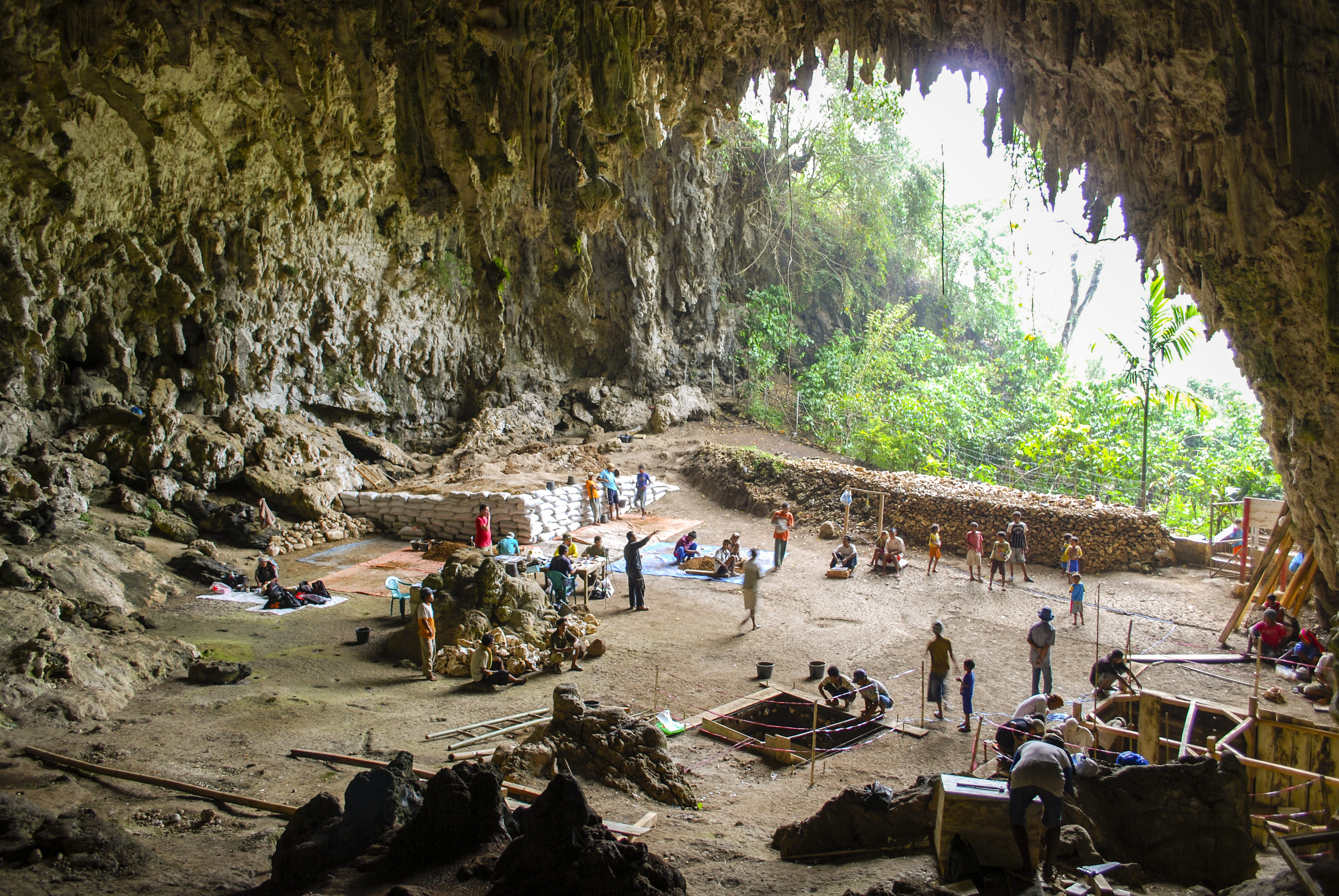印度尼西亚梁步遗址出土佛罗勒斯人属的地层学和年代学修订
Revised Stratigraphy and Chronology for Homo floresiensis at Liang Bua in Indonesia
托马斯·苏提那 Thomas Sutikna
(澳大利亚伍伦贡大学 University of Wollongong)
马修·塔休瑞 Mathew Tocheri
(加拿大莱克黑德大学 Lakehead University)
佛罗勒斯人是在更新世晚期灭绝的人类的一支,在印度尼西亚佛罗勒斯岛的山洞沉积中发现后,激起了世界范围的激烈科学讨论以及在任何学科很罕见的公众关注。2004年十月份,《自然》杂志公布了这一发现,即:有这样一种新的人类,他们同样是双腿直立行走并且可以使用石质工具,但是成年人的直立身高只有一米,而且大脑极小,仅与大猩猩的脑容量(400 CC)相同,此外,他们还具备过去一百五十万年以来的人类所不见的其他原始特征。这一震惊世界的发现直到今天仍被大家关注,它表明,更新世晚期的人类多样性要比今天丰富的多。换句话说,我们的人类物种曾经和其他种的人类共享这个地球。佛罗勒斯人究竟遭遇了什么到目前为止还所知甚少,但是最近基于过去十年考古工作的证据表明,佛罗勒斯人应该在六万到五万年前从梁布亚地区消失,而不是以前认为的一万八到一万二千年前。

最初测年结果被定在九万五到一万二千年之前,这些结果意味着佛罗勒斯人在佛罗勒斯生存的时间晚于现代人离开东南亚群岛并抵达澳大利亚的时间。在佛罗勒斯地区,现代人和佛罗勒斯人有三四万年的重合时间自然让人困惑,并对之前更新世晚期澳大利亚和其他东南亚岛屿的现代人证据提出了挑战。而佛罗勒斯地区最早的现代人类的证据也来自梁布亚,且年代限制在一万一千年。不过,在梁布亚进一步的发掘和研究澄清了这个年代学的问题。

骨骼被认为在100,000 到 60,000年之前,和他们对应的石器测年为190,000和50,000年前。地层学序列上,佛罗勒斯相关沉积层的年代为46,000年前。在佛罗勒斯人最早被发现的地区,其基岩是侵蚀表面并且向北部倾斜下降。在基层之上是年代晚于20,000年的沉积——就是这些沉积造成了先前年代的错误。经过校对的年代包括对三个个体骨骼的放射性铀测年。相关测年说明沉积的最小年代范围是86.9 ± 7.9 到 71.5 ± 4.3 ka (LB1), 71.4 ± 1.1 到 66.7 ± 0.8 ka (LB2)和 66.0 ± 4.3 到 54.6 ± 2.1 ka (LB6)。 所有和佛罗勒斯相关的骨骼和文化遗物的年代都在60,000到50,000年前,这一测年结果综合了热释光等多种测年方法。另外,可信的证据表明,现代人出现于佛罗勒斯地区的年代在41,000 年前,甚至可能早到46,000年前。

基于最新的序列和年代学证据,现在
佛罗勒斯人
作为佛罗勒斯人的典型遗址,梁布亚对佛罗勒斯人的消失时间和原因的相关理论的检测至关重要。但对50,000到20,000年前的沉积的发掘很有限。2017年,在洞穴中部的新发掘专门针对的问题是:相关大型动物群的存活年代是否晚于50,000年前?之所以选择这个区域发掘,是因为之前的试掘表明这些沉积的年代在50,000到20,000年前,并且发现了超过3,000件在原址保留的遗物和47,000件过筛发现的遗物,这些发现还需进一步鉴定分析。到目前为止还没有确定的佛罗勒斯人和大型动物骨骼发现,相反的是,所有发现的遗存都是小型动物,多是老鼠和蝙蝠。这表明这里的佛罗勒斯人和其他大型动物可能在50,000年前已灭绝,但这也需要对佛罗勒斯其他地区的进一步研究。如果在佛罗勒斯其他地方,这些动物群在距今50,000年以后还存在,很可能在他们最终灭绝之前都没有再返回梁布亚。相反的,我们目前发现的遗存和石制品的特征都表明其与现代人间的相关性。所有的证据表明,虽然直到全新世早期现代人类分布于梁布亚的人口密度都很低,但在此地的最早出现年代在46,000年前。在佛罗勒斯地区的考古发掘中,佛罗勒斯人在50,000年之后是否还存在仍然是需要进一步解决的问题。
The discovery of Homo floresiensis, a human species that went extinct during the Late Pleistocene, from deep within cave sediments on the Indonesian island of Flores sparked intense scientific debates worldwide and attracted a level of public interest rarely seen in any discipline. Announced to the world on October 28, 2004 in the journal Nature, the discovery revealed another human species that also walked on two legs and made and used stone tools; however, adults stood only ~1 m tall and had extremely small, chimpanzee-sized brains (~400 cc), as well as body proportions and other primitive features not seen within the genus Homo for the past ~1.5 million years. The implications of this remarkable discovery continue reverberating to this day. It is clear that human biological and cultural diversity was significantly greater during the Late Pleistocene than it is now when the only humans left are members of a single species, Homo sapiens (modern humans). In other words, our species once shared this planet with Neandertals and Denisovans as well as H. floresiensis. What exactly happened to this particular branch of our human family tree is still poorly understood, but recently published evidence—based on almost ten years of additional archaeological research—shows that H. floresiensis disappears from Liang Bua ~60–50 thousand years (ka) ago, and not 18–12 ka ago, as originally suggested.
Initially dated to ~95–12 ka ago, these ages implied that H. floresiensis survived on Flores long after modern humans had dispersed across Island Southeast Asia and reached Australia by ~50 ka ago. The 30–40 millennia of potential overlap between modern humans and H. floresiensis (and pygmy Stegodon) on Flores was certainly perplexing and challenging to explain relative to the evidence in favor of modern humans in Australia and elsewhere in Island Southeast Asia during the Late Pleistocene, but the earliest evidence for modern humans on Flores was also from Liang Bua and was restricted to the last 11 ka. However, continued excavations and research at Liang Bua have helped clarify this confounding chronological issue.
Based on new stratigraphic and chronological evidence, the skeletal remains of H. floresiensis are now recognized to be between ~100 and 60 ka old, while stone artefacts reasonably attributable to this species range from ~190 to 50 ka old. Stratigraphically, the H. floresiensis-bearing sediments are part of a pedestal of remnant deposits that date to more than ~46 ka. In the areas where H. floresiensis was first discovered, this pedestal has an erosional upper surface that slopes steeply downwards to the north. Unconformably overlying the pedestal are sediments younger than ~20 ka in age and initial misinterpretation of this unconformity led to the errors in inferring the latest occurrences of H. floresiensis. The revised chronology for H. floresiensis evidence includes estimates based on uranium-series dating (234U/230Th) of bones from three individuals. Ulnae belonging to the holotype and two other adults have modelled 234U/230Th ages (± 2σ), which reflect minimum ages of deposition, ranging from 86.9 ± 7.9 to 71.5 ± 4.3 ka (LB1), 71.4 ± 1.1 to 66.7 ± 0.8 ka (LB2), and 66.0 ± 4.3 to 54.6 ± 2.1 ka (LB6). All skeletal and cultural materials thus far attributed to H. floresiensis stratigraphically underlie volcanic tephras (T1 and T3) estimated to be ~60 and 50 ka old, respectively, based on a combination of dating methods that includes infrared stimulated luminescence, thermoluminescence, 234U/230Th, and 40Ar/39Ar. Moreover, credible evidence suggesting that modern humans were on Flores by ~41 ka cal. BP or possibly even as early as ~46 ka cal. BP is emerging from their ongoing research at the site.
As the type site of H. floresiensis, Liang Bua is critical for testing hypotheses about how, when and why this enigmatic species became extinct, but excavation of sediments ~50–20 ka in age has been limited. New excavations were carried out in 2017 over ~12 m2 in the middle rear of the cave to specifically test whether H. floresiensis and associated large endemic fauna survived after ~50 ka. This area of the cave was targeted because our previous test excavations in this area showed that the sediments are between ~50 and 20 ka in age. More than 3,000 findings were recovered in position and more than 47,000 findings were also recovered from sieved sediments. Although these findings require further study, no diagnostic skeletal remains of H. floresiensis, Komodo dragon, giant marabou stork or vulture were found. A single fragment of Stegodon enamel was recovered but this was almost certainly reworked from older deposits. Instead, all of the recovered remains represent smaller animals, mostly rats and bats. This evidence suggests that H. floresiensis and these other large taxa disappeared from the area and were likely extinct (except Komodo dragon) by ~50 ka but further exploration of other sites on Flores is needed. If these taxa did indeed survive elsewhere on Flores after ~50 ka, then they likely never returned to Liang Bua before ultimately going extinct. Instead, the behavioural evidence of hominins we recovered included several more hearth and hearth-like features as well as stone artefacts with roughly equal proportions made of chert and silicified tuff, a pattern seen with modern humans at the site during the Holocene but not in the H. floresiensis-bearing sediments. Together these findings add to the growing corpus of data that suggests modern humans were present at Liang Bua beginning ~46 ka ago, although likely in relatively low population densities until the early Holocene. Whether H. floresiensis survived after 50 ka ago remains an intriguing question that further archaeological research on Flores will hopefully clarify.
